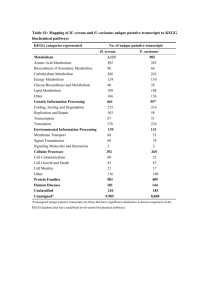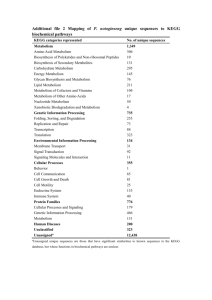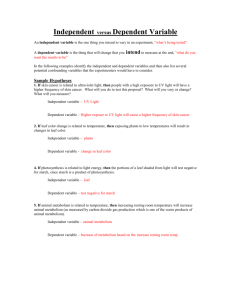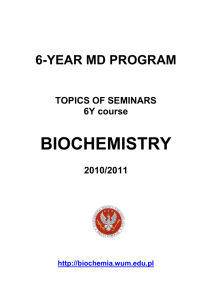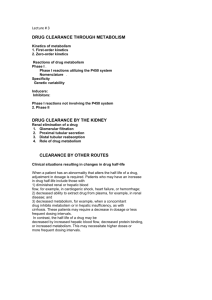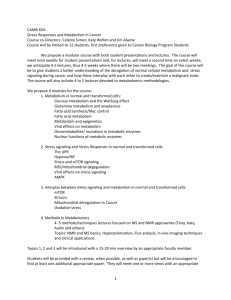tentative ILOs for Biochemistry 2
advertisement
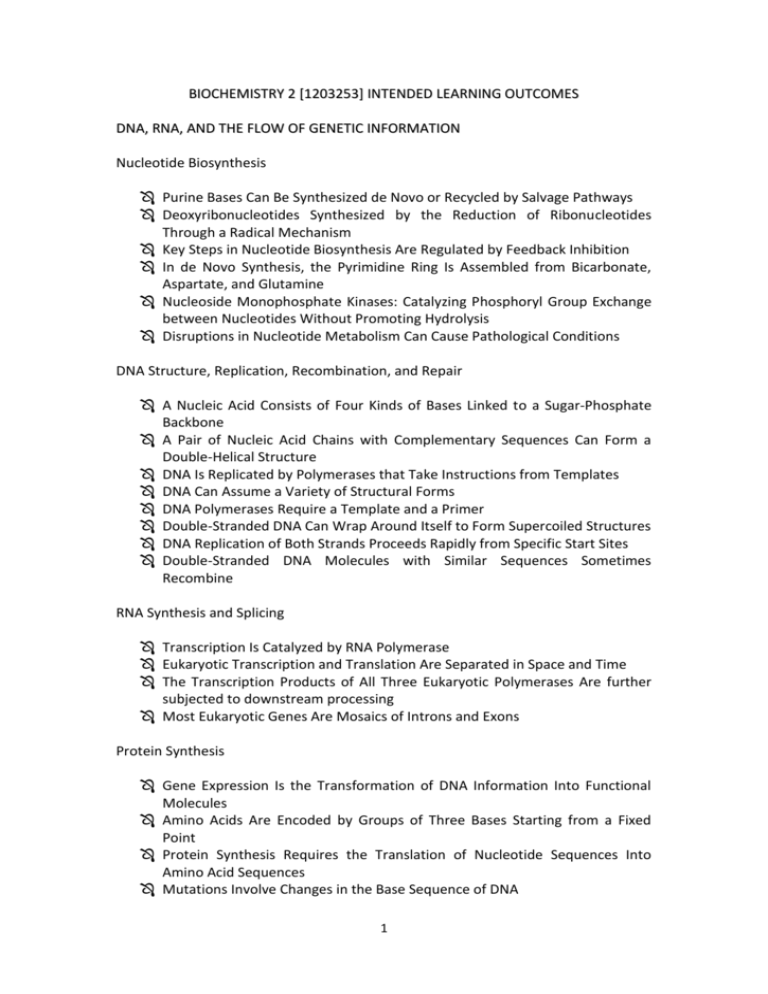
BIOCHEMISTRY 2 [1203253] INTENDED LEARNING OUTCOMES DNA, RNA, AND THE FLOW OF GENETIC INFORMATION Nucleotide Biosynthesis Purine Bases Can Be Synthesized de Novo or Recycled by Salvage Pathways Deoxyribonucleotides Synthesized by the Reduction of Ribonucleotides Through a Radical Mechanism Key Steps in Nucleotide Biosynthesis Are Regulated by Feedback Inhibition In de Novo Synthesis, the Pyrimidine Ring Is Assembled from Bicarbonate, Aspartate, and Glutamine Nucleoside Monophosphate Kinases: Catalyzing Phosphoryl Group Exchange between Nucleotides Without Promoting Hydrolysis Disruptions in Nucleotide Metabolism Can Cause Pathological Conditions DNA Structure, Replication, Recombination, and Repair A Nucleic Acid Consists of Four Kinds of Bases Linked to a Sugar-Phosphate Backbone A Pair of Nucleic Acid Chains with Complementary Sequences Can Form a Double-Helical Structure DNA Is Replicated by Polymerases that Take Instructions from Templates DNA Can Assume a Variety of Structural Forms DNA Polymerases Require a Template and a Primer Double-Stranded DNA Can Wrap Around Itself to Form Supercoiled Structures DNA Replication of Both Strands Proceeds Rapidly from Specific Start Sites Double-Stranded DNA Molecules with Similar Sequences Sometimes Recombine RNA Synthesis and Splicing Transcription Is Catalyzed by RNA Polymerase Eukaryotic Transcription and Translation Are Separated in Space and Time The Transcription Products of All Three Eukaryotic Polymerases Are further subjected to downstream processing Most Eukaryotic Genes Are Mosaics of Introns and Exons Protein Synthesis Gene Expression Is the Transformation of DNA Information Into Functional Molecules Amino Acids Are Encoded by Groups of Three Bases Starting from a Fixed Point Protein Synthesis Requires the Translation of Nucleotide Sequences Into Amino Acid Sequences Mutations Involve Changes in the Base Sequence of DNA 1 Aminoacyl-Transfer RNA Synthetases Read the Genetic Code A Ribosome Is a Ribonucleoprotein Particle (70S) Made of a Small (30S) and a Large (50S) Subunit Protein Factors Play Key Roles in Protein Synthesis Eukaryotic Protein Synthesis Differs from Prokaryotic Protein Synthesis Primarily in Translation Initiation and subsequent coupling reactions. The Gene Expression Regulation Prokaryotic DNA-Binding Proteins Bind Specifically to Regulatory Sites in Operons The Greater Complexity of Eukaryotic Genomes Requires Elaborate Mechanisms for Gene Regulation Transcriptional Activation and Repression Are Mediated by Protein-Protein Interactions Some Receptors Dimerize in Response to Ligand Binding and Signal by Crossphosphorylation Gene Expression Can Be Controlled at Posttranscriptional Levels Molecular basis of inherited diseases Restriction Enzymes: Performing Highly Specific DNA-Cleavage Reactions DNA recombinations are helpful in establishing genomic as well as cDNA libraries Antibiotic resistance genes can select for the transfected cloning vector. The utility of Sanger dideoxy method is basically for purified DNA sequencing. Restriction Fragment Length Polymorphism analysis is a direct diagnostic tool of sickle cell disease. Polymerase chain reaction is highly advantageous in detecting/tracing low abundance nucleic acid sequences Microarray technique is quite a handy Analytical means of determinations of the gene expression products. ELISA and Western blots can be Important Techniques to investigate specific proteins. TRANSDUCING & STORING OF ENERGY INTERMEDIARY METABOLISM Glycolysis and Gluconeogenesis Metabolism Is Composed of Many Coupled, Interconnecting Reactions The Oxidation of Carbon Fuels Is an Important Source of Cellular Energy Glycolysis Is an Energy-Conversion Pathway in Many Organisms The Glycolytic Pathway Is Tightly Controlled Glucose Can Be Synthesized from Noncarbohydrate Precursors Gluconeogenesis and Glycolysis Are Reciprocally Regulated 2 Citric Acid Cycle The Citric Acid Cycle Oxidizes Two-Carbon Units Entry to the Citric Acid Cycle and Metabolism Through It Are Controlled The Citric Acid Cycle Is a Source of Biosynthetic Precursors. Amino Acids Are Made from Intermediates of the Citric Acid Cycle and Other Major Pathways The Pentose Phosphate Pathway the Pentose Phosphate Pathway Generates NADPH and Synthesizes FiveCarbon Sugars The Metabolism of Glucose 6-Phosphate by the Pentose Phosphate Pathway Is Coordinated with Glycolysis Glucose 6-Phosphate Dehydrogenase Plays a Key Role in Protection Against Reactive Oxygen Species Glycogen, hexoses and disaccharides Metabolism Glycogen Breakdown Requires the Interplay of Several Enzymes Phosphorylase Is Regulated by Allosteric Interactions and Reversible Phosphorylation Epinephrine and Glucagon Signal the Need for Glycogen Breakdown Glycogen Is Synthesized and Degraded by Different Pathways Glycogen Breakdown and Synthesis Are Reciprocally Regulated All hexoses are to be phosphorylated before they are any further metabolized Hexose epimerase can substitute for lacking dietary sources of galactose Lactose synthesis is mainly mediated by galactosyltransferases LIPID METABOLISM Fatty Acid Metabolism Triacylglycerols Are Highly Concentrated Energy Stores The Utilization of Fatty Acids as Fuel Requires Three Stages of Processing Certain Fatty Acids Require Additional Steps for Degradation Fatty Acids Are Synthesized and Degraded by Different Pathways Acetyl Coenzyme A Carboxylase Plays a Key Role in Controlling Fatty Acid Metabolism via Carnitinr shuttle modulation Elongation and Unsaturation of Fatty Acids Are Accomplished by Accessory Ketogenesis is strictly hepatic and ketone bodies can be consumed by brain as well as muscle cells The Biosynthesis of Membrane Lipids and Steroids Phosphatidic acid Is a Common Intermediate in the Synthesis of Phospholipids and Triacylglycerols Cholesterol Is Synthesized from Acetyl Coenzyme A in Three Stages 3 The Complex Regulation of Cholesterol Biosynthesis Takes Place at Several Levels Important Derivatives of Cholesterol Include Bile Salts and Steroid Hormones PROTEIN TURNOVER AND AMINO ACID CATABOLISM Proteins Are Degraded to Amino Acids Protein Turnover Is Tightly Regulated Many Enzymes Are Activated by Specific Proteolytic Cleavage The First Step in Amino Acid Degradation Is the Removal of Nitrogen Ammonium Ion Is Converted Into Urea in Most Terrestrial Vertebrates Carbon Atoms of Degraded Amino Acids Emerge as Major Metabolic Intermediates Inborn Errors of Metabolism Can Disrupt Amino Acid Degradation Amino Acids Are Precursors of Many Biomolecules THE INTEGRATION OF METABOLISM Metabolic Pathways Contain Many Recurring Motifs Metabolism Consist of Highly Interconnected Pathway Each Organ Has a Unique Metabolic Profile Food Intake and Starvation Induce Metabolic Changes Ethanol Alters Energy Metabolism in the Liver Peptide hormones, namely insulin and glucagon, are actively involved in reciprocal regulation of metabolism during absorptive and postabsorptive phases 4 Course Contents and Schedule Subject lectures Introduction Storage and expression of genetic information. Nucleotide metabolism. DNA structure and replication RNA structure and synthesis Protein Synthesis Regulation of gene expression Molecular basis of inherited disease Intermediary metabolism. Glycolysis. Gluconeogenesis. Hexose Monophosphate pathway Citric acid cycle. MIDTERM Carbohydrate metabolism Glycogen metabolism. Metabolism of monosaccharides and disaccharides Lipid metabolism. Metabolism of dietary lipids. Fatty acid and triacylglycerol metabolism. Phospholipid metabolism Cholesterol and steroid metabolism. Nitrogen metabolism. Disposal of Nitrogen. Metabolism of carbon skeleton. Conversion of amino acids to specialized products Integration of metabolism. Metabolic effects of insulin and glucagon. Metabolism in the well-fed state. Metabolism in starvation and diabetes mellitus FINAL EXAM References: - Lippincott’s Biochemistry 4th edition, Champe PC, Harvey RA and Ferrier DR., 2008. - Lehninger’s principles of Biochemistry 3rd edition, edited by Nelson D.L. and Cox M.M., 2000. - Biochemistry 4th edition, Stryer L., 1995. Lecture notes are available on http://blackboard.ju.edu.jo User name: pharm_std Password: pharm_std 5 No. of 1 3 3 2 3 3 5 2 2 2 2 2 2 2 1 3 2 1 1 1 1 1


